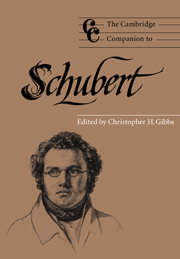Book contents
- Frontmatter
- Introduction: the elusive schubert
- Part I Contexts: musical, political, and cultural
- Part II Schuberts music: style and genre
- 6 Schubert's songs: the transformation of a genre
- 7 Schubert's social music: the “forgotten genres”
- 8 Schubert's piano music: probing the human condition
- 9 Schubert's chamber music: before and after Beethoven
- 10 Schubert's orchestral music: “strivings after the highest in art”
- 11 Schubert's religious and choral music: toward a statement of faith
- 12 Schubert's operas: “the judgment of history?”
- Part III Reception
- Notes
- Index
8 - Schubert's piano music: probing the human condition
from Part II - Schuberts music: style and genre
Published online by Cambridge University Press: 28 September 2011
- Frontmatter
- Introduction: the elusive schubert
- Part I Contexts: musical, political, and cultural
- Part II Schuberts music: style and genre
- 6 Schubert's songs: the transformation of a genre
- 7 Schubert's social music: the “forgotten genres”
- 8 Schubert's piano music: probing the human condition
- 9 Schubert's chamber music: before and after Beethoven
- 10 Schubert's orchestral music: “strivings after the highest in art”
- 11 Schubert's religious and choral music: toward a statement of faith
- 12 Schubert's operas: “the judgment of history?”
- Part III Reception
- Notes
- Index
Summary
for alfred brendel on his 65th birthday
Long underestimated, Schubert's compositions for piano have recently begun to assume their rightful place beside Beethoven's legacy as works of almost unparalleled expressive range and depth. Several factors contributed to their neglect: the fact that much of this music remained unpublished during Schubert's lifetime; the dominance, in these works, of musical expression over technical virtuosity; and the overpowering influence of Beethoven, whose works set standards that are not directly applicable to Schubert. Complaints of an alleged looseness of organization in Schubert's music, as expressed by critics like Theodor W. Adorno, who once described Schubert's thematic structure as a “potpourri,” have often arisen from an inadequate understanding of the aesthetic idiom of these works. Schubert's music is less deterministic than Beethoven's in that it does not present a self-sufficient sequence of events; it seems that the music could have taken a different turn at many points. Yet these very shifts in perspective are often exploited by Schubert as structural elements in the musical form, and they also embody a latent psychological symbolism. A key to this symbolism is found in Schubert's songs, in which the protagonist, or Romantic wanderer – who assumes the role of the lyrical subject – is so often confronted by an indifferent or hostile reality. Musically, Schubert uses a combination of heightened thematic contrast, juxtaposition of major and minor keys, and abrupt modulation to reflect this duality between internal and external experience, or imagination and perception – between the beautiful, bright dreams of the protagonist, on the one hand, and a bleak external reality, on the other.
- Type
- Chapter
- Information
- The Cambridge Companion to Schubert , pp. 155 - 173Publisher: Cambridge University PressPrint publication year: 1997
- 1
- Cited by



